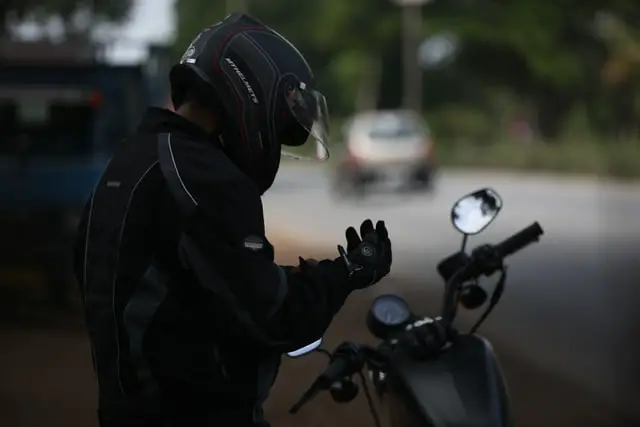As the Summer months bleed into Autumn and the leaves begin their shift to reds and oranges, there is one thing that is certain temperatures are going to drop. As a motorcycle enthusiast you want to get the longest use from your bike despite the cold weather sweeping in.

High tech jackets and pants with high levels of insulation will keep you comfortable on those long rides through the brisk morning or evening air. State-of-the-art helmets will keep you safe and warm on any ride, but what about your hands?
Why Do Your Hands Get So Cold When You Ride A Motorcycle?
Before we can look at the best ways to keep your hands warm when you’re out for a ride, we first must figure out why they get so cold in the first place. As you reach speeds upwards of 80 miles an hour (or roughly 128 km/h) the first part of your body to break through the air, is your hands tightly gripped around the handlebars of your motorcycle. There are a few factors to consider when evaluating why your hands are so cold.
As you ride, your hands are exposed to air passing quickly over your skin. The cold air and the speed at which you move through it are quickly whisking a way the heat from your exposed flesh. This will lower the temperature in your hands to an uncomfortable level, quickly.

The other factor that contributes to the loss of temperature in your hands is how tightly you are gripping your handlebars. As you hold on tighter, the blood that circulates through you hand is pushed back into your arm, leaving the blood flow in your hand limited. The continuous pumping of blood through your hand helps to warm your appendages.
Limited blood flow means that the temperature in your hands will remain low for the duration of your ride.
So, What Can You Do To Make Sure That Your Hands Stay Warm And Comfortable?
The most obvious answer may be the correct one. You could wear gloves to help protect your skin when you ride. A pair of gloves will keep the heat trapped near your hands, keeping the temperature up. Gloves may protect your hands from the wind which will allow your hand to heat up, without being directly affected by the cold air.
With many options for gloves on the market, you may be wondering which type of gloves are the best? Some are better than others.
What Type Of Motorcycle Gloves Work The Best?
Fleece or cotton gloves are a cheap option that may be accessible in most department or convenience stores. Fleece or cotton gloves are soft and fluffy and feel very nice on the skin. They do an effective job at insulating the hands so that the fingers continuously feel warm.
These gloves may be great for cool days, but they may not stand up to the cold, chilly winds you’ll be facing when you ride. Because fleece and cotton gloves are knit together, they have very small holes in between the pieces of fabric.
In very low temperature or when riding into the wind, these gloves let the heat from your hands escape through their small holes. The holes in these gloves also allow the wind to reach your skin cooling it off even faster and causing possible damage to your epidermis.
Last update on 2024-03-21 / Images from Amazon Product Advertising API
Gloves made of canvas, traditionally used for work, may be an option to keep your hands warm while you ride. These gloves are usually made of a rougher material in order to protect your hands when doing physical labour. The threads of these gloves are much closer together than their cotton or fleece counterparts. This allows canvas gloves to keep the cold wind from reaching your hands.
Canvas gloves are often thin and do not provide much insulation to your fingers. This lack of insulation will allow the heat from your hands to quickly dissipate through the thin layer of canvas. Without a thick layer of insulation to hold the heat tightly to your hands, your hands will still feel ice cold despite the cold wind being deflected.
Traditionally, motorcycle riders have adopted leather as their material of choice for jackets and chaps. This is most likely due to the wind resistance and thickness of quality leather hide. Others believe that motorcycle wear closely mirrors the cowboys of the west and leather mimics the chaps and vests of old cowboys. Despite the reasoning for this traditional garb, are leather gloves also the best option for keeping your hands warm on a long ride?
Leather comes from the hide of a cow and leather products are usually made from a single hide that has been treated for use. Unlike cotton or canvas, leather is not made of stitched fibres. Its single piece of hide makes leather a great resistor of wind. Because it does not have any holes, leather will not allow the harsh winds to reach your hands. It also means that the heat naturally created from your hands will have nowhere to escape.

The thickness of leather also contributes to its ability to keep your hands warm on a cool afternoon ride. The thick leather hide traps the heat from your hands and continues to stay warm for an extended amount of time. Leather’s original use is to trap heat within the body of an animal, and it continues to perform this task when made into gloves.
A pair of leather gloves lined with fleece or wool may be your best bet for keeping your hands insulated and warm.
Adjusting Your Grip When Riding Your Motorbike
Motorcyclists grip the handlebars of their bike firmly as they ride. Most often, handlebars are at an angle that put the arms in a vertical position that makes it harder for blood to circulate to your hands. As they squeeze the handles, the warm blood in their fingers is pushed out of their hands and into their arms. This could limit the amount of internal heating that comes from your hands.

To combat this, try releasing your grip and stretching your hands when your bike comes to a stop. Shaking the hands quickly or rotating at the wrists will pump blood back into your fingers quickly. Try holding your arms down at your sides during a stop to let gravity help your hands circulate blood.
As you ride, if it is safe to do so, try loosening your grip to allow more blood to circulate through your hands. This circulation will bring warm blood from your torso out into your fingers, allowing your blood to heat your hands from the inside out. Without good blood circulation, you could lose responsiveness in your hands, increasing the danger that you face while out for a ride. Keeping good circulation in your fingers will not only keep your hands warm, but it will keep you safe as well.
Keeping your hands warm and protected when the temperatures drops is essential to the enjoyment of riding. Insulated hands mean that you can ride all day long without having to stop to warm your hands.
Cold hands are slower to respond in emergency situations.
Keeping your hands warm will add to your overall safety and response time when riding at high speeds. Protecting your skin from the wind will keep your hands from drying out and your top skin layers from cracking. This can be painful and may require medical attention if not prevented properly. Keeping your hands covered will result in a more enjoyable ride.







